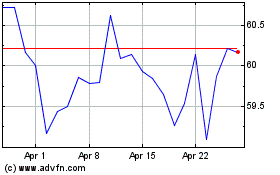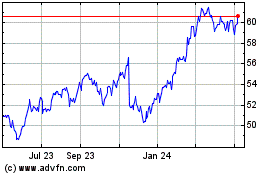5 Billion Reasons Toys 'R' Us Struggles as Amazon Soars
July 18 2017 - 3:45PM
Dow Jones News
By Miriam Gottfried
Toys "R" Us Inc. will get a new website this summer as it
struggles to compete online with its cash-rich rivals. The toy
retailer, laden with $5 billion in debt, has spent $100 million
over the past several years to help boost its online sales.
That won't stop the toy chain from falling further behind its
rivals. Wal-Mart Stores Inc. bought Jet.com last August for $3.3
billion and since then has purchased three more online retailers.
Target Corp. is investing billions to lower prices and improve
online sales.
Toys "R" Us is one of many retailers fighting to keep up. High
debt loads, increasingly nervous lenders and falling sales make it
impossible to invest enough to compete online. And when companies
do generate online sales, the margins are so tight that future
investments are harder to make.
Macy's Inc. had $5.5 billion in net debt at the end of the first
quarter. A year ago, it said it would improve its performance and
use the cash to pay down debt. Instead, the retailer struggled and
had to use nearly two-thirds of its free cash flow last year to pay
off $750 million in maturing debt. It bought back more this year,
further hurting its ability to fund plans to revive sales,
including improving its mobile app and expanding its off-price
concept Backstage to more stores.
Worries that borrowing will become more expensive or won't be
there at all have prompted some relatively healthy companies to
focus on paying down their debt, which further limits the amount
they can invest.
Retailers sold just four high-yield bonds this year worth $2.8
billion, compared with seven bonds worth $5.7 billion last year.
That is down from a 20-year peak of 28 bonds totaling $10.7 billion
in 2013, according to Dealogic. The amount of retail bank and bond
debt rated by Moody's is up 65% since 2007.
Toys "R" Us and other struggling chains can likely survive for
years, but they will constantly struggle to catch up with the
competition while still turning a profit. During holiday 2015, the
toy retailer had to resort to "sales prevention" by halting some
online deals after a deluge of web orders overwhelmed its ability
to get products to customers in time for Christmas. The company had
planned to launch its new website ahead of Christmas 2016 but was
forced to delay it to fully test the new platform.
On a conference call with analysts June 15, Chief Executive
David Brandon said a clunky online registry tool and the lack of a
subscription feature for parents to receive regular shipments of
diapers and other products were holding back Toys "R" Us's baby
business.
"It's just one of a number of examples where we're limited in
terms of how we can compete until we transition over to our new
website," Mr. Brandon said.
Meanwhile, Amazon.com Inc. sold an estimated $4 billion worth of
toys last year, more than a third of what Toys "R" Us sells,
according to analytics firm One Click Retail. Amazon's toy sales
were up 24%, compared with 5% for the overall market and five years
of declines for Toys "R" Us.
For big retail chains, one of the few levers left to pull are
store closures. "We're in a period where we're going to see
indefinite top-line and gross-margin declines until there have been
enough store closures," said Jenna Giannelli, a retail credit
analyst at Citigroup. Store closures will likely continue for the
next five years or so as leases expire, she said.
Toys "R" Us, which was taken private in 2005 in a $6.6 billion
leveraged buyout by Bain Capital, KKR & Co. and Vornado Realty
Trust, has swapped debt coming due this year and next for
longer-term debt with a higher interest rate. Analysts expect it to
do the same with another $400 million bond due next year, but that
could be tough. On June 20, S&P Global Ratings lowered its
outlook for the retailer, saying that if markets are nervous or the
company's business gets worse, it might not be able to pay off that
bond when it comes due.
Toys "R" Us declined to comment.
Macy's has been forced to rethink its strategy in other ways. In
March 2015, Chief Financial Officer Karen Hoguet said the company
"liked having control of our real estate." That November, Macy's
announced it was exploring joint ventures for its four flagship
properties. In 2016, it sold its men's store in San Francisco's
Union Square, reached an agreement to sell its downtown Minneapolis
store and began work on a plan to shrink its store on Chicago's
State Street to make way for a buyer or joint-venture partner.
When Macy's laid out plans at its investor day June 6 for a
revamped marketing strategy and greater focus on exclusive
products, it warned that its 2017 gross-margin rate could be weaker
than it had expected in February. The company cited excess
inventory and bigger discounting in the beauty business. As
recently as November 2016, Macy's was touting lower inventory
levels.
Write to Miriam Gottfried at Miriam.Gottfried@wsj.com
(END) Dow Jones Newswires
July 18, 2017 15:30 ET (19:30 GMT)
Copyright (c) 2017 Dow Jones & Company, Inc.
Walmart (NYSE:WMT)
Historical Stock Chart
From Mar 2024 to Apr 2024

Walmart (NYSE:WMT)
Historical Stock Chart
From Apr 2023 to Apr 2024
